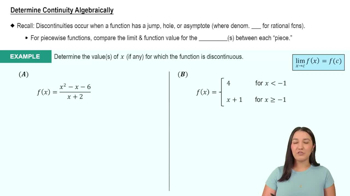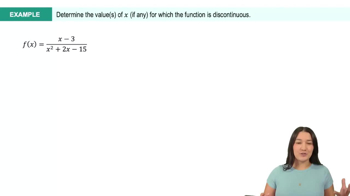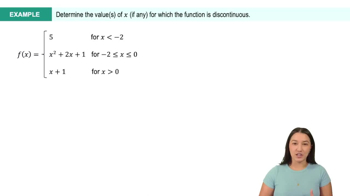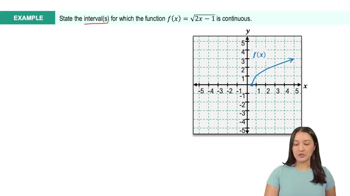Table of contents
- 0. Functions7h 52m
- Introduction to Functions16m
- Piecewise Functions10m
- Properties of Functions9m
- Common Functions1h 8m
- Transformations5m
- Combining Functions27m
- Exponent rules32m
- Exponential Functions28m
- Logarithmic Functions24m
- Properties of Logarithms34m
- Exponential & Logarithmic Equations35m
- Introduction to Trigonometric Functions38m
- Graphs of Trigonometric Functions44m
- Trigonometric Identities47m
- Inverse Trigonometric Functions48m
- 1. Limits and Continuity2h 2m
- 2. Intro to Derivatives1h 33m
- 3. Techniques of Differentiation3h 18m
- 4. Applications of Derivatives2h 38m
- 5. Graphical Applications of Derivatives6h 2m
- 6. Derivatives of Inverse, Exponential, & Logarithmic Functions2h 37m
- 7. Antiderivatives & Indefinite Integrals1h 26m
- 8. Definite Integrals4h 44m
- 9. Graphical Applications of Integrals2h 27m
- 10. Physics Applications of Integrals 2h 22m
1. Limits and Continuity
Continuity
Problem 2.8d
Textbook Question
Limits and Continuity
On what intervals are the following functions continuous?
d. k(x) = sin x / x
 Verified step by step guidance
Verified step by step guidance1
First, recall the definition of continuity: a function is continuous at a point if the limit of the function as it approaches the point from both sides is equal to the function's value at that point.
Consider the function k(x) = sin(x) / x. This function is defined for all x except x = 0, because division by zero is undefined.
To determine the intervals of continuity, we need to check where the function is defined and where it is continuous. Since k(x) is undefined at x = 0, it cannot be continuous there.
For x ≠ 0, the function is continuous because both sin(x) and x are continuous functions, and the quotient of two continuous functions is continuous wherever the denominator is non-zero.
Therefore, the function k(x) = sin(x) / x is continuous on the intervals (-∞, 0) and (0, ∞).
 Verified video answer for a similar problem:
Verified video answer for a similar problem:This video solution was recommended by our tutors as helpful for the problem above
Video duration:
1mPlay a video:
Was this helpful?
Key Concepts
Here are the essential concepts you must grasp in order to answer the question correctly.
Limits
Limits are fundamental in calculus, representing the value that a function approaches as the input approaches a certain point. They are crucial for understanding continuity, as a function is continuous at a point if the limit exists and equals the function's value at that point. For the function k(x) = sin x / x, evaluating the limit as x approaches 0 is essential to determine its continuity.
Recommended video:

One-Sided Limits
Continuity
A function is continuous at a point if three conditions are met: the function is defined at that point, the limit exists at that point, and the limit equals the function's value. For k(x) = sin x / x, we need to check its behavior at x = 0 and other points to determine where it is continuous. Understanding the definition of continuity helps in identifying intervals of continuity for various functions.
Recommended video:

Intro to Continuity
Piecewise Functions
Piecewise functions are defined by different expressions over different intervals. For k(x) = sin x / x, it is important to recognize that while the function is not defined at x = 0, it can be extended to be continuous by defining k(0) = 1, which is the limit of k(x) as x approaches 0. This concept is vital for analyzing functions that may have discontinuities at specific points.
Recommended video:
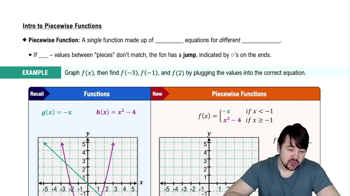
Piecewise Functions
Related Videos
Related Practice




